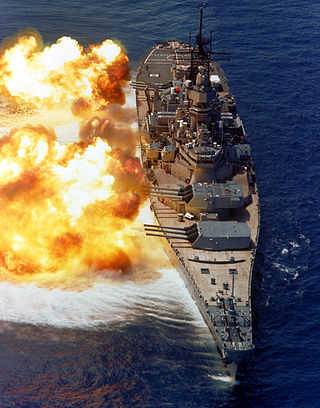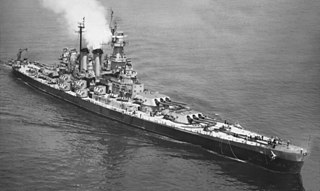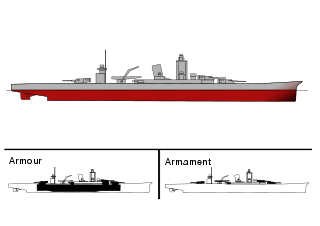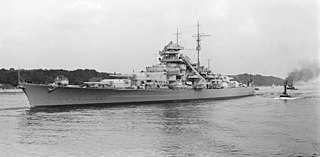
The Montana-class battleships were planned as successors of the Iowa class for the United States Navy, to be slower but larger, better armored, and with superior firepower. Five were approved for construction during World War II, but changes in wartime building priorities resulted in their cancellation in favor of continuing production of Essex-class aircraft carriers and Iowa-class battleships before any Montana-class keels were laid.

USS Kentucky (BB-66) was an uncompleted battleship intended to be the last ship of the Iowa class. Hull BB-66 was originally to be the second ship of the Montana-class battleships. However, the urgent need for more warships at the outbreak of World War II and the U.S. Navy's experiences in the Pacific theater led it to conclude that rather than battleships larger and more heavily armed than the Iowa class, it quickly needed more fast battleships of that class to escort the new Essex-class aircraft carriers being built. As a result, hulls BB-65 and BB-66 were reordered and laid down as Iowa-class battleships in 1942.

USS Illinois (BB-65) was the fifth Iowa-class fast battleship that was laid down for the United States Navy during World War II in the 1940s, although she would not be completed. The Navy had initially planned on building four of the Iowas and then developing a new, more powerful ship for what was to be BB-65. The pressing need for more warships at the outbreak of World War II in Europe led the Navy to conclude that new designs would have to be placed on hold to allow the shipbuilding industry to standardize on a small number of designs. As a result, BB-65 was ordered to the Iowa design in 1940. Illinois was laid down in December 1942, but work was given a low priority, and was still under construction at the end of World War II. She was canceled in August 1945, but her hull remained as a parts hulk until she was broken up in 1958.

The Iowa class was a class of six fast battleships ordered by the United States Navy in 1939 and 1940. They were initially intended to intercept fast capital ships such as the Japanese Kongō class and also serve as the "fast wing" in a traditional battle line alongside slower battleships. The Iowa class was designed to meet the Second London Naval Treaty's "escalator clause" limit of 45,000-long-ton (45,700 t) standard displacement. Beginning in August 1942, four vessels, Iowa, New Jersey, Missouri, and Wisconsin, were completed; two more, Illinois and Kentucky, were laid down but canceled in 1945 and 1958, respectively, before completion, and both hulls were scrapped in 1958–1959.

The North Carolina class were a pair of fast battleships, North Carolina and Washington, built for the United States Navy in the late 1930s and early 1940s.

The Alaska class were six very large cruisers ordered before World War II for the United States Navy, of which only two were completed and saw service late in the war. The US Navy designation for the ships of this class was 'large cruiser' (CB) and the majority of leading reference works consider them as such. However, various other works have alternately described these ships as battlecruisers despite the US Navy having never classified them as such. The Alaskas were all named after territories or insular areas of the United States, signifying their intermediate status between larger battleships and smaller heavy and light cruisers.

The King George V-class battleships were the most modern British battleships in commission during the Second World War. Five ships of this class were built: HMS King George V, HMS Prince of Wales (1941), HMS Duke of York (1941), HMS Anson (1942) and HMS Howe (1942). The names honoured King George V, and his sons, Edward VIII, who had been Prince of Wales, and George VI who was Duke of York before ascending to the throne; the final two ships of the class were named after prominent 18th century admirals of the Royal Navy.

HMS Vanguard was a British fast battleship built during the Second World War and commissioned after the war ended. She was the largest and fastest of the Royal Navy's battleships, the only ship of her class, and the last battleship to be built.

Vittorio Veneto was the second member of the Littorio-class battleship that served in the Italian Regia Marina during World War II. The ship's keel was laid down in October 1934, launched in July 1937, and readied for service with the Italian fleet by August 1940. She was named after the Italian victory at Vittorio Veneto during World War I, and she had three sister ships: Littorio, Roma, and Impero, though only Littorio and Roma were completed during the war. She was armed with a main battery of nine 381-millimeter (15.0 in) guns in three triple turrets, and could steam at a speed of 30 knots.

The Scharnhorst class was a class of German battleships built immediately prior to World War II. The first capital ships of Nazi Germany's Kriegsmarine, it comprised two vessels: Scharnhorst and Gneisenau. Scharnhorst was launched first, and is considered to be the lead ship by some sources; they are also referred to as the Gneisenau class in some other sources, as Gneisenau was the first to be laid down and commissioned. They marked the beginning of German naval rearmament after the Treaty of Versailles. The ships were armed with nine 28 cm (11 in) SK C/34 guns in three triple turrets; plans to replace these with six 38 cm (15 in) SK C/34 guns in twin turrets were never realized.

Seydlitz was a heavy cruiser of Nazi Germany's Kriegsmarine, fourth in the Admiral Hipper class, but was never completed. The ship was laid down in December 1936 and launched in January 1939, but the outbreak of World War II slowed her construction and fitting-out work was finally stopped in the summer of 1940 when she was approximately 95 percent complete. The unfinished ship remained pier-side in the shipyard until March 1942, when the Kriegsmarine decided to pursue aircraft carriers over surface combatants. Seydlitz was among the vessels chosen for conversion into auxiliary aircraft carriers.

The Lion class was a class of six fast battleships designed for the Royal Navy (RN) in the late 1930s. They were a larger, improved version of the preceding King George V class, with 16-inch (406 mm) guns. Only two ships were laid down before the Second World War began in September 1939 and a third was ordered during the war, but their construction was suspended shortly afterwards. The design was modified in light of war experience in 1942, but the two ships already begun were scrapped later in the year.

The South Dakota class was a group of four fast battleships built by the United States Navy. They were the second class of battleships to be named after the 40th state; the first were designed in the 1920s and canceled under the terms of the Washington Naval Treaty. Four ships comprised the class: South Dakota, Indiana, Massachusetts, and Alabama. They were designed to the same treaty standard displacement limit of 35,000 long tons (35,600 t) as the preceding North Carolina class and had the same main battery of nine 16"/45 caliber Mark 6 guns in three-gun turrets, but were more compact and better protected. The ships can be visually distinguished from the earlier vessels by their single funnel, compared to twin funnels in the North Carolinas.

Design B-65 was a class of Super Type A cruisers planned by the Imperial Japanese Navy (IJN) before and during World War II. As envisioned by the IJN, the cruisers were to play a key role in the Night Battle Force portion of the "Decisive battle" strategy which Japan hoped, in the event of war, to employ against the United States Navy.

The O class was a planned class of three battlecruisers for the Kriegsmarine before World War II. Prompted by a perceived lack in ship numbers when compared with the British Royal Navy, the O class' design was born with the suggestion of modifying the P-class cruiser design with 380 mm (15 in) guns instead of 283 mm (11.1 in).

Roma, named after two previous ships and the city of Rome, was the third Littorio-class battleship of Italy's Regia Marina. The construction of both Roma and her sister ship Impero was due to rising tensions around the world and the navy's fear that only two Littorios, even in company with older pre-First World War battleships, would not be enough to counter the British and French Mediterranean Fleets. As Roma was laid down almost four years after the first two ships of the class, some small improvements were made to the design, including additional freeboard added to the bow.

The Bismarck class was a pair of fast battleships built for Nazi Germany's Kriegsmarine shortly before the outbreak of World War II. The ships were the largest and most powerful warships built for the Kriegsmarine; displacing more than 41,000 metric tons normally, they were armed with a battery of eight 38 cm (15 in) guns and were capable of a top speed of 30 knots. Bismarck was laid down in July 1936 and completed in September 1940, while her sister Tirpitz's keel was laid in October 1936 and work finished in February 1941. The ships were ordered in response to the French Richelieu-class battleships. They were designed with the traditional role of engaging enemy battleships in home waters in mind, though the German naval command envisioned employing the ships as long-range commerce raiders against British shipping in the Atlantic Ocean. As such, their design represented the strategic confusion that dominated German naval construction in the 1930s.

USS Guam was an Alaska-class large cruiser which served with the United States Navy during the last year of World War II. She was the second and last ship of her class to be completed. The ship was the second vessel of the US Navy to be named after the island of Guam, an American territory in the Pacific, and she was assigned the hull number CB-2. Due to her commissioning late in the war, Guam saw relatively limited service during the war. She participated in operations off Okinawa in March–July 1945, including providing anti-aircraft defense for the carrier task force and conducting limited shore bombardment operations. She participated in sweeps for Japanese shipping in the East China and Yellow Seas in July–August 1945. After the end of the war, she assisted in the occupation of Korea and transported a contingent of US Army troops back to the United States. She was decommissioned in February 1947 and placed in reserve, where she remained until she was stricken in 1960 and sold for scrapping the following year.

USS Alaska was the lead ship of the Alaska class of large cruisers which served with the United States Navy during the end of World War II. She was the first of two ships of her class to be completed, followed only by Guam; four other ships were ordered but were not completed before the end of the war. Alaska was the third vessel of the US Navy to be named after what was then the territory of Alaska, and was assigned the hull number CB-1. She was laid down on 17 December 1941, ten days after the United States entered the war, was launched in August 1943 by the New York Shipbuilding Corporation, in Camden, New Jersey, and was commissioned in June 1944. She was armed with a main battery of nine 12 in (305 mm) guns in three triple turrets and had a top speed of 33 kn.




















